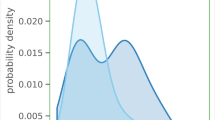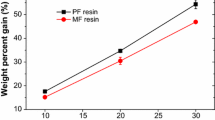Abstract
Polyvinyl chloride overlaid veneered plywood (PVC-VP), melamine-impregnated paper overlaid veneered plywood (MI-VP) and unfinished plywood (UF-P) were used as the experimental materials to explore the emission characteristics of volatile organic compounds (VOCs) and different VOC components from plywood under different loading factors. A 15L small chamber and gas chromatography-mass spectrometer were used as equipment. Under the conditions of a temperature of 23.5 °C ± 1 °C, relative humidity of 50% ± 5%, gas exchange rate of 1 h−1, and loading factors of 1m2m−3, 1.5m2m−3, 2m2m−3, 2.5m2m−3, VOCs were collected from plywood on days 1, 3, 7, 14, 21 and 28 for analysis. The results showed that the loading factors had a greater impact on VOCs released from veneered plywood in the early stage, but a smaller impact in the later stage. However, loading factors influenced the middle and late stages of VOCs release from UF-P. Aromatic hydrocarbons account for the largest proportion in VOC components in plywood, and their decreasing rate increased with the loading factors. Polyvinyl chloride (PVC) and melamine-impregnated paper contain olefins and esters, which were released rapidly before the balanced period. The relationship between VOCs released from plywood and loading factors was nonlinear and affected by the use of decorative materials. Therefore, the fitting curves of PVC-VP, MI-VP and UF-P had different functional relationships due to the different surface decorations.



Similar content being viewed by others
References
Costa NA, Ohlmeyer M, Ferra J, Magalhães FD, Mendes A, Carvalho L (2014) The influence of scavengers on VOC emissions in particleboards made from pine and poplar. Eur J Wood Prod 72:117–121
De Gennaro G, Loiotile AD, Fracchiolla R, Palmisani J, Saracino MR, Tutino M (2015) Temporal variation of VOC emission from solvent and water-based wood stains. Atmos Environ 115:53–61
Du C, Shen J (2015) Comparison of the rapid testing method for VOCs-emissions from wood-based panels with the chamber method. J Scientia Silvae Sinicae 03:112–118 (In Chinese)
Höllbacher E, Ters T, Rieder-Gradinger C, Srebotnik E (2016) Influences of interior fitting processes on the indoor air quality of two model rooms. Eur J Wood Prod 74:693–701
ISO 16000-9 (2006) Indoor Air-Part 9: Determination of the emission of volatile organic compounds from building products and furnishing—Emission test chamber method. International Organization for Standardization, Geneva
Jiang LQ, Shen J, Li HW, Wang QF, Shen XW (2018) Effects of volatile organic compounds released by different decorative particleboards on indoor air quality. BioResources 13:7595–7605
Kim KW, Kim S, Kim HJ, Park JC (2010) Formaldehyde and TVOC emission behaviors according to finishing treatment with surface materials using 20 L chamber and FLEC. J Hazard Mater 177(1/3):90–94
Liang W, Lv M, Yang M (2016) The combined effects of temperature and humidity on initial emittable formaldehyde concentration of a medium-density fiberboard. J Build Environ 98:80–88
Lin JF (2014) Study on the emission law of formaldehyde from man-made board of indoor decoration. J Chem Eng Equip 3:41–44 (In Chinese)
Liu Y, Zhu XD (2014) Measurement of formaldehyde and VOCs emissions from wood-based panels with nanomaterial-added melamine-impregnated paper. J Constr Build Mater 66:132–137
Liu Y, Shen J, Zhu XD (2010) Effect of temperature, relative humidity and ach on the emission of volatile organic compounds from particleboard. Adv Mat Res 113–116:1874–1877
Liu WJ, Shen J, Wang QF (2017) Design of DL-SW micro-cabin for rapid detection and analysis of VOCs from wood-based panels. J For Eng 4:37–42+58 (In Chinese)
Li S, Shen J, Jiang SM (2013) Characteristics of VOC emissions from plywood in different environment factors. Scientia Silvae Sinicae 49(1):179–184 (In Chinese)
Lv ZZ (2018) Problems and countermeasures of export trade of plywood manufacturing enterprises in China. J Pract Foreign Econ Relat Trade 351(04):54–57. https://doi.org/10.3969/j.issn.1003-5559.2018.04.013(In Chinese)
Madureira J, Paciência I, Pereira C, Teixeira JP, Fernandes EDO (2016) Indoor air quality in Portuguese schools: levels and sources of pollutants. Indoor Air. https://doi.org/10.1111/ina.12237
Park JY, Lee SM, Park BD, Lim JY, Jang SG, Kim S (2013) Effect of surface laminate type on the emission of volatile organic compounds from wood-based composite panels. J Adhes Sci Technol 27(5–6):620–631
Shao YL, Shen J, Shen XW (2018) Qin JK (2018) Effect of panel area-volume ratio on TVOC released from decorative particleboards. Wood Fiber Sci 50:132–142
Shen J, Jiang LQ (2018) A review of research on VOCs release from wood-based panels. J For Eng 3(06):1–10 (In Chinese)
Wang QF, Shen J, Zhao Y, Liu WJ (2017) Influence of environmental factors on volatile organic compound emissions from plywood tested by a rapid detection method. For Prod J 68(3):272–280
Zhang YM (2015) Influence of building materials on indoor air quality and its evaluation. J Chem Enterp Manag 15(17):220–221
Zhang WC, Shen J (2011) Research in characteristics of VOC release from interior overlaid particleboard. D. Northeast Forestry University, Harbin (In Chinese)
Zhao Y (2015) Measuring the VOC emission-releasing and assessment of the impact of plywood on the indoor environment. J Saf Environ 15(01):316–319
Zheng YL, Zhao Y, Zhu MT, Yu M, Wang QF, Shen J (2015) Releasing rule and characteristics of VOC emissions from plywood by the rapid detection. J Northeast For Univ 06:122–125 (In Chinese)
Zhu XD, Liu Y, Shen J (2016) Volatile organic compounds (VOCs) emissions of wood-based panels coated with nanoparticles modified water-based varnish. Eur J Wood Prod 74(4):601–607
Acknowledgements
The authors gratefully acknowledge the financial support of The National Key Research and Development Program of China (2016YFD0600706).
Author information
Authors and Affiliations
Corresponding author
Additional information
Publisher's Note
Springer Nature remains neutral with regard to jurisdictional claims in published maps and institutional affiliations.
Rights and permissions
About this article
Cite this article
Cao, T., Shen, J., Wang, Q. et al. Influence of loading factors on VOCs emission from veneered plywood. Eur. J. Wood Prod. 78, 1287–1293 (2020). https://doi.org/10.1007/s00107-020-01557-2
Received:
Published:
Issue Date:
DOI: https://doi.org/10.1007/s00107-020-01557-2




